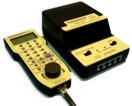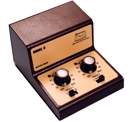| Brand: |
Atlas |
| Part Number: |
20000817 |
| Scale / Type: |
HO Scale |
| Our Code: |
AL20000817 |
The development of shipping containers reached a turning point in the late 1970s when standardization began to take place. Prior to this time numerous designs and sizes of containers were seen throughout the world. The true intermodal era began in the 1980s with the expanding world economy, Panama Canal ship size restrictions, intermodal railway car (wagon) designs and the setting of ISO standards for international shipping containers.
Steel became the norm and two heights of 40-foot containers eventually became standard worldwide; the standard-height (8' 6") and the high-cube (9' 6").
In addition to ISO size standardization, assembly-line manufacturing standardization brought the steel container from various aluminum and steel designs to a more similar design. In the late 1970s squared corrugations with double logo panels were common new-builds. The next step, occurring during the early 80s changed the squared corrugations to a beveled design. Finally, in the late 80s, the logo panels were no longer seen on new-builds and the all-corrugated side container emerged as most production was shifted to China.
Today's commonly seen steel all-corrugated ISO containers still have some variations, primarily the doors. The new Atlas model will be a standard-height 40'er which will exhibit a range of door styles, roofs, and front walls to more closely match the variations in the prototype containers seen throughout the world.
There are two major sizes of ISO 40-foot freight containers;
High-cube and standard-height. The standard height container, with an outside height of 8'6", is the more commonly seen worldwide of the two. The ISO has assigned the following size-type codes to this style of container: 4300, 4310, 42G0, 42G1.
Two other manufacturers of HO scale models produce 40-foot high-cube containers. Now, Atlas is proud to introduce the 40-foot standard-height model meticulously rendered for its HO scale Master Line.
Which Paint Schemes are being offered this run?
"Maersk I.": The Danish company Maersk is the largest ship-owning container line in the world. There have been a number of major paint schemes since the Eighties. The "Maersk I" paint scheme features the word "Maersk" on both container sides and the front wall. Although various paint schemes were produced, the "Maersk I" is the only one to specifically feature the "Maersk" on the front wall. This scheme was introduced in the mid-to-late-Eighties and can still be seen today.
Safmarine: Originally formed in 1946 as South African Marine Corporation Limited (Safmarine), this South African line was acquired by Maersk, a Danish company, in the late Nineties. The company still operates under the Safmarine name and can be seen in ports throughout the world.
Hanjin "www": Hanjin is a large Korean shipping company. Atlas' "www" release features the web address on the sides., Prototypically, of the many Hanjin paint schemes produced, the "www" paint scheme is uniquely featured with the 42 corrugation sides and 1-1 door with LTR handles.
DSR-Senator (SPKU): DSR-Senator was formed by way of merger in 1994 between Deutsche Seereederei Rostock and Senator Linie. In 1997 DSR-Senator hit financial hardship which led to the acquisition of 80% of its holdings by Hanjin Shipping Company. Containers featuring the SPKU reporting marks are leased by an outside company to this alliance made up of Hanjin Shipping Co., Ltd., Deutsche Seereederei Rostock GmbH and Senator Line GmbH & Co. KG (Bremen). Although no longer being produced, this paint scheme can still be seen today throughout the world.Features:- First HO 40-foot model to feature production rail guides
- First HO 40-foot standard-height model to feature roof corner pads
- First 1-(1-1) or “Maersk” style door model in any scale
- First 1-1 door style in HO scale
- First LTR style handles
- Separately applied door rods and handles
- Optional separate vents
- Prototypically accurate “beveled” all corrugated sides
|
|
|
























